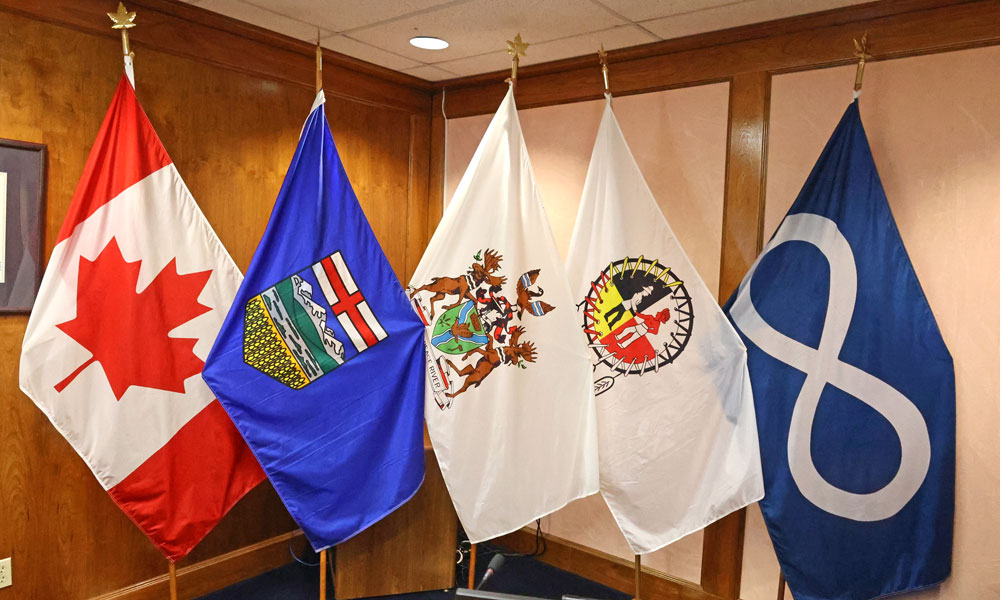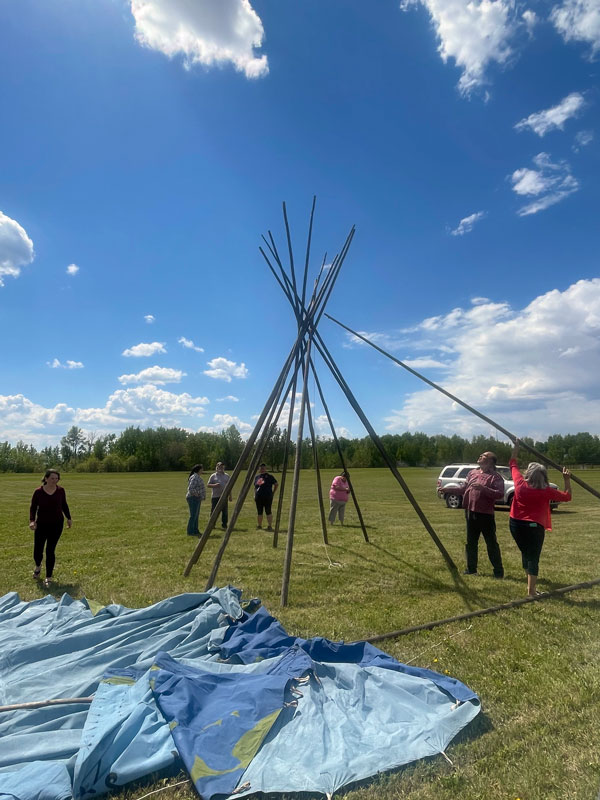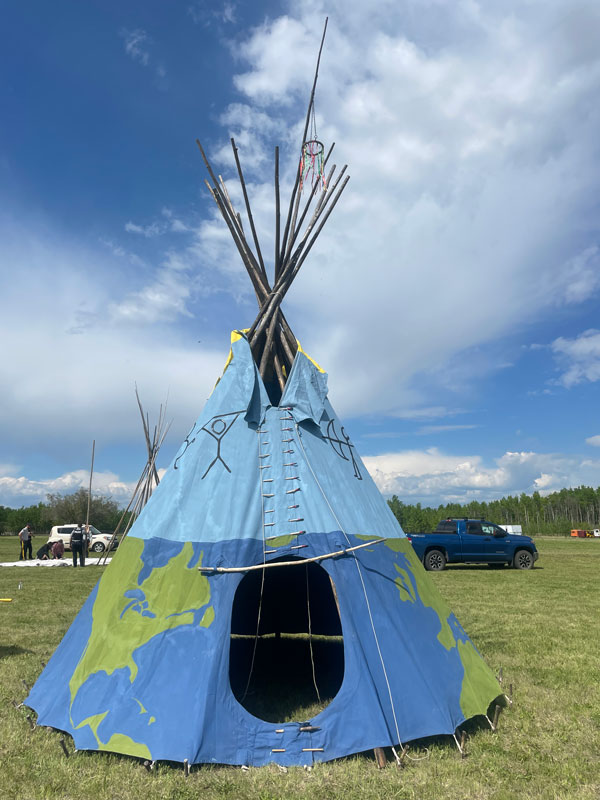
THROUGH A CULTURALLY-RELEVANT COLLABORATION WITH members of Indigenous organizations, Dr. Judy Gillespie hopes to use cultural strengths and community-based approaches to improve child and family wellbeing, and combat the destructive legacy of colonial relationships with First Nation peoples.
Dr. Gillespie, now an Associate Professor in UBCO’s School of Social Work, was first taken down this path years ago as a social worker in Grande Prairie, Alberta. “One thing I saw repeatedly was the families that did best in child welfare cases were those who had stronger connections within their communities. The families that didn’t do well were more disconnected,” she explains.
“While I was doing my doctoral research regarding the role of community in child and family well-being, I kept getting told I really needed to connect with the Peace River Aboriginal Interagency Committee (PRAIC).”
Dr. Gillespie was intrigued by the PRAIC model, which as it turns out, did something rare at the time in Canada. In Peace River, a northern Alberta town of 8,000 people, PRAIC members live and work on the surrounding traditional territories of the Woodland Cree, Beaver, and Dene nations. Its work also encompasses several Métis communities in Alberta Métis Regions 5 and 6.
PRAIC strives to connect with different sectors of the local community and bring them together to address issues of well-being for Indigenous peoples living in the area.

Peace River Town Council is one of the few towns that hangs flags in their Council Chambers of the nations on whose ancestral homelands the town is located. Pictured left to right are the flags of Canada, the province of Alberta, the town of Peace River, the Treaty 8 Confederacy and the Métis Nation.
“I was really interested in their work because they aren’t just comprised of social service agencies, which is usually what you see,” says Dr. Gillespie. But in Peace River, she continues, PRAIC includes partners like the local museum, library and town council. The list also includes representatives of local municipal districts, First Nations, Métis and other Indigenous partners*.
“It’s an incredibly multi-sector group involving local communities, which enhances well-being in the region. They advocate and promote social change, which is really fascinating.”
Dr. Gillespie worked with PRAIC to learn how it tackles health and social issues in the region. Anecdotally, she saw that the PRAIC process seemed to encourage respect of varied perspectives and enable joint efforts between the many community factions. That seemed to lead to better outcomes for Indigenous peoples in Peace River.
“I’ve seen transportation issues identified as well as dental care for children. Peace River was also among the first communities in Canada to host a Sisters in Spirit memorial to draw attention to the issue of missing and murdered Indigenous women.”
As effective as the PRAIC approach appeared to her, Dr. Gillespie realized that if she could record and share data evaluating the impacts of the PRAIC model, it might enable collaborative approaches in other areas. That was important, she says, “because we live in this data-based world where governments don’t want to spend money on something unless they’re seeing results. But there was very little research or literature in this area.”

Dr. Judy Gillespie and Research Assistant Violet Noskey learn how to set up a teepee with the help of PRAIC Elder and research advisory committee member Dennis Whitford. Assembling the teepee enabled cultural teachings and learning within the community.

The fully assembled teepee, which is a significant cultural aspect for most prairie First Nations. The teepee was a critical part of the pow wow and gathering held by the Peace River Aboriginal Interagency Committee.
Joining forces with Dr. Jason Albert of First Nations University of Canada, Dr. Gillespie received funding to enable an empirical study of how evaluation of multi-sector initiatives can include Indigenous knowledge.
In addition to PRAIC, the two researchers also connected with an organization called səxʷkn̓xitəlx k̓l̓ c̓əc̓málaʔ (a Syilx term that roughly translates as “those who care for the children”). Also known as the Indigenous Early Years Table of the Central Okanagan, the organization, based in the Central Okanagan traditional territory of the Syilx nation, as well as Region 3 communities for the Métis Nation of British Columbia, is a collaborative group consisting of Elders, Métis Community Services Society, Ki-Low-Na Friendship Society, Okanagan Nation Alliance, Westbank First Nation and community partners including School District 23 and Interior Health.
The group’s mandate is to promote collaboration, planning and advocacy of services that contribute to the health and well-being of young Indigenous children. This includes opportunities for families to connect to their traditions, culture and language in the Central Okanagan—located in traditional unceded Syilx territory.
“All of these organizations together work towards healthy child development, through promoting children as sacred gifts who can flourish and take pride in their traditions, culture and language,” says Kim Kosik, səxʷkn̓xitəlx k̓l̓ c̓əc̓málaʔ coordinator.

Dr. Judy Gillespie.
Representatives from səxʷkn̓xitəlx k̓l̓ c̓əc̓málaʔ in Dr. Gillespie’s research included Elder Jessie Nyberg, Canoe Creek Band of the Secwepmc (Shuswap) Nation; Maria Laboucan, Central Okanagan Métis Family Services; Kelly L’Hirondelle, former Executive Director, Métis Community Services Society; and Kim Kosik, Coordinator.
An important early step for the research team was establishing trusting relationships with community representatives within both PRAIC and səxʷkn̓xitəlx k̓l̓ c̓əc̓málaʔ. Western-based approaches to social research have seldom worked collaboratively with Indigenous partners, notes Dr. Gillespie, who is seeking to change that.
“It’s been a huge learning curve for me. I am not First Nations, I am not Métis. My degree is from a university grounded in western ways of thinking. So learning has involved a lot of listening and a lot of reflection.”
The first year of Dr. Gillespie’s research with both groups was spent building relationships. With səxʷkn̓xitəlx k̓l̓ c̓əc̓málaʔ representatives this involved several meetings and sharing of food. The research with PRAIC representatives—Elder Gaylene Whitehead, Northern Sunrise Municipal District; Elder Dennis Whitford, Sagitawa Friendship Centre Board Chair and 2 Thunder Consulting; and Elder Dave Matilpi, Sagitawa Friendship Centre Board Chair—began through ceremony and a feast.
As the research got underway, Dr. Gillespie and her doctoral student Kelsey Darnay engaged the group in talking circles and guided conversations.
Darnay, who is of Anishnaabe and European descent, previously worked with the Niagara Regional Native Centre as an Indigenous criminal court worker in Ontario. After witnessing first-hand the systemic discrimination in Canada’s criminal justice system against Indigenous peoples, she pursued a master’s degree in Canadian and Indigenous studies. Her thesis then explored the over-incarceration of Indigenous peoples in Canada.

This canoe was named kwkeyumaʔ senk̓lip after two baby coyotes were seen visiting the log before the project started. Carved by Westbank First Nation Youth and Master Carver Frank Marchand and his apprentice Will Poitras, the canoe is symbolic of the journey of səxʷkn̓xitəlx k̓l̓ c̓əc̓málaʔ table members. They wanted to reflect on their journey as an approach to evaluation, exploring the challenges and milestones along the way.
Now a doctoral student in UBCO’s Interdisciplinary Graduate Studies program in Community Engagement, Social Change, and Equity, Darnay is doing research on Indigenous restorative justice as an alternative to incarceration. In September 2022, she began assisting Dr. Gillespie with a number of important elements in her research projects.
“I’ve led guided conversations with members of PRAIC and səxʷkn̓xitəlx k̓l̓ c̓əc̓málaʔ, attended the talking circles, and have contributed to the ethics application and initial report.
“The most memorable experiences I’ve had with the team are the cultural teachings we received from PRAIC and Elders. Dr. Gillespie ensures that Indigenous methodologies and approaches lead this research and that’s very important to me.”
There is a delicacy born of respect when conducting this sort of research with First Nations, says Dr. Gillespie. “Ceremony is very important.” There were other matters to sensitively navigate as well. “Recording conversations and interviews for transcription is a typical western research method. But in some communities it’s not customary to record people during talking circles. So, we had to seek permission for that.”
Dr. Gillespie’s UBCO community-engaged research, which incorporates some of the 94 Calls to Action from the Truth and Reconciliation Commission of Canada, is a rare weave of culturally relevant Indigenous knowledge shared by communities and theoretical social science applications.
As for what her research has revealed so far, Dr. Gillespie notes that multi-sector collaborations to address social issues aren’t a one-size-fits-all approach. In the case of PRAIC and səxʷkn̓xitəlx k̓l̓ c̓əc̓málaʔ—they are sharing their perspectives and deciding what works best for them when it comes to caring for their children.
*There can be anywhere from 20-30 representatives for the project; past and current names of individuals involved include: Peace River Museum: formerly Laura Love, now Allisa Dullemond; Peace River Library: Channing Stenhouse; Peace River Town Council: Elaine Manzer; Northern Sunrise Municipal District representative and Elder: Gaylene Whitehead; Northwest Region Community and Social Services, Aboriginal Services: Wendy Goulet; Sagitawa Friendship Centre Board Chair, Elder, and 2 Thunder Consulting: Dennis Whitford; Peace River Victim Services: Jordan Broadhead. Current Sagitawa Friendship Centre Board Chair and local Elder Dave Matilpi.
**Main image of the Town of Peace River courtesy of Jeff Bartlett.